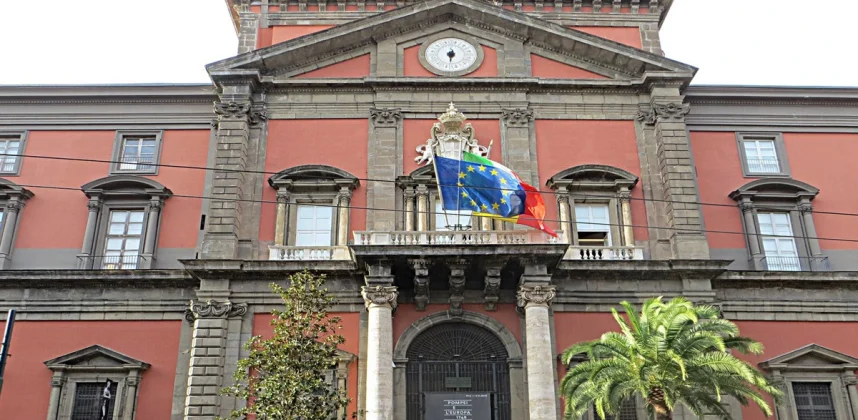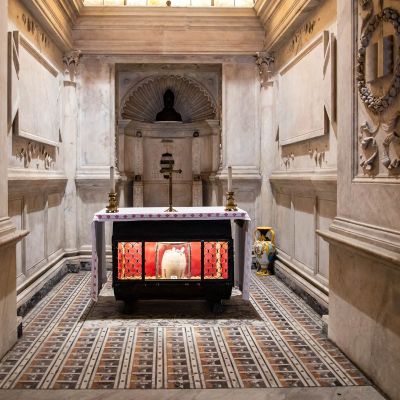Naples, a city where history breathes through its streets and museums, welcomes a mesmerizing blend of contemporary art and ancient heritage at the National Archaeological Museum of Naples (MANN). British artist Philip Colbert, renowned for his bold and vibrant creations, has brought his latest exhibition, “House of the Lobster”, to this iconic Neapolitan museum.
Known for his large-scale lobster-themed artworks, Colbert’s exhibition in Naples is a spectacle of color, history, and myth, creating a unique dialogue between modern art and ancient Roman mosaics. This article will guide you through the heart of Colbert’s exhibition, unveiling the synergy between his dynamic art and Naples’ rich historical tapestry.
The National Archaeological Museum of Naples (MANN) is more than just a museum; it’s a portal to the past, offering a profound connection to the ancient world. Through its vast and varied collections, MANN not only preserves history but also brings it to life, allowing visitors to walk in the footsteps of ancient Romans, Greeks, and Egyptians.
The museum’s permanent exhibits, the evocative Pompeii collections, and its famous artifacts together create an unparalleled historical tapestry. These exhibits do not just display objects; they tell stories, evoke emotions, and provoke thought. They remind us of the grandeur, complexity, and also the fragility of ancient civilizations.
Visiting MANN is not just an educational experience; it’s a journey through time. It’s an opportunity to understand our past, to see the origins of our culture, and to reflect on the human experience across millennia. The museum plays a crucial role in the cultural landscape of Naples, enhancing the city’s rich heritage and making it a must-visit destination for tourists from all over the world.
As you leave the halls of the National Archaeological Museum of Naples, you carry with you the stories, the images, and the wonder of the ancient world, a testament to humanity’s enduring legacy.
Philip Colbert: The Artist and His Vision
From January 26th to April 1st, 2024, the British artist Philip Colbert returns to Naples with the exhibition “House of the Lobster,” a site-specific project for the MANN, the National Archaeological Museum of Naples.
Philip Colbert, a contemporary British artist, has established himself as a unique voice in the art world. Known for his larger-than-life lobster motifs, his work is a vibrant blend of pop art and a deep commentary on modern culture. Colbert’s artistic journey began with a fascination for the boldness of pop art icons and has evolved to include various mediums ranging from painting and sculpture to fashion and digital art.
The lobster, a recurring element in his work, is not just a whimsical choice but a symbol of his artistic identity. It represents a bridge between the natural world and the artist’s imagination, often depicted in surreal and unexpected contexts. For Colbert, the lobster is a canvas for exploring contemporary issues, making bold statements through its vivid presence.
In “House of the Lobster,” this motif takes center stage, with each piece reflecting Colbert’s fascination with blending historical references and modern-day narratives. The exhibition is a journey through his artistic vision, where visitors are invited to explore the depths of his creativity and the breadth of his influences.
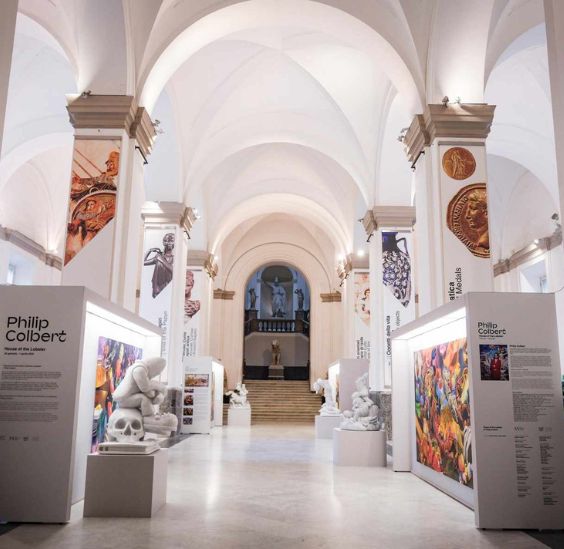
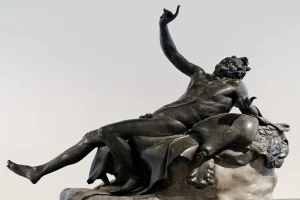
Tour of the Archaeological Museum of Naples
Step back in time on this 3-hour tour of the Archaeological Museum of Naples and discover a trove of ancient Greek and Roman art. Accompanied by an expert guide, browse archaeological treasures unearthed in Pompeii and Herculaneum; marvel over colorful mosaics and ancient frescos; and see iconic sculptures like the Farnese Bull and Atlas.
The Exhibition: ‘House of the Lobster’ at MANN
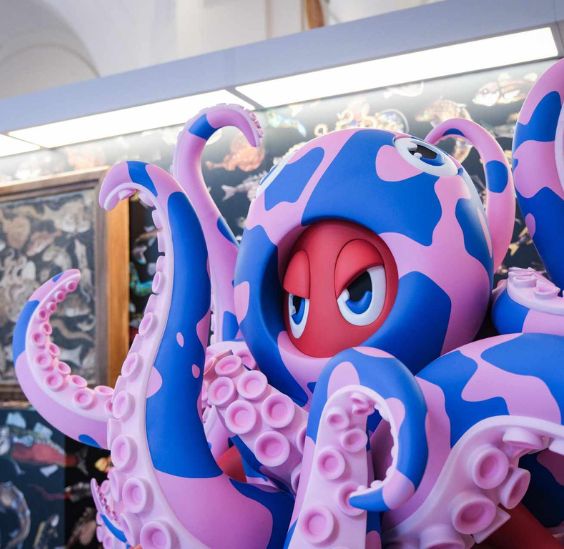
The “House of the Lobster” exhibition at the National Archaeological Museum of Naples is a stunning display of Philip Colbert’s unique artistic language. Upon entering, visitors are greeted by an array of sculptures and paintings, each piece a testament to Colbert’s skill in merging classical art forms with contemporary themes.
Key artworks in the exhibition include large-scale marble and bronze sculptures that echo the grandeur of ancient Roman art. These pieces stand alongside vibrant oil paintings, where the lobster is depicted in various narratives, some whimsical, others more introspective.
The exhibition’s layout is thoughtfully designed to create a dialogue between Colbert’s works and the museum’s existing collection. Notably, his pieces are in conversation with the famous mosaics from the House of the Faun in Pompeii, offering a modern reinterpretation of these ancient artworks. This interplay between the old and the new is a central theme of the exhibition, inviting viewers to see the connections between different eras of artistic expression.
The Fusion of Contemporary Art and Ancient History
Philip Colbert’s “House of the Lobster” at the National Archaeological Museum of Naples serves as a bridge between ancient history and modern art. The exhibition cleverly juxtaposes Colbert’s contemporary pieces with the museum’s rich collection of Roman artifacts, particularly the mosaics from Pompeii. This interplay is not just a visual feast but a thematic exploration, where Colbert’s art dialogues with the past.
In his works, Colbert often delves into themes of conflict, mythology, and the human condition, mirroring the narratives found in ancient art. The centerpiece of the exhibition, a dramatic mosaic depicting a battle between a lobster, a moray eel, and an octopus, is a prime example. This piece, while modern in execution, resonates deeply with the themes of struggle and survival inherent in ancient Roman art.
The reaction of visitors to this fusion is a testament to its power. The exhibition has been praised for making ancient art accessible and relevant to a contemporary audience, offering a new perspective on the timeless themes depicted in these historical pieces.

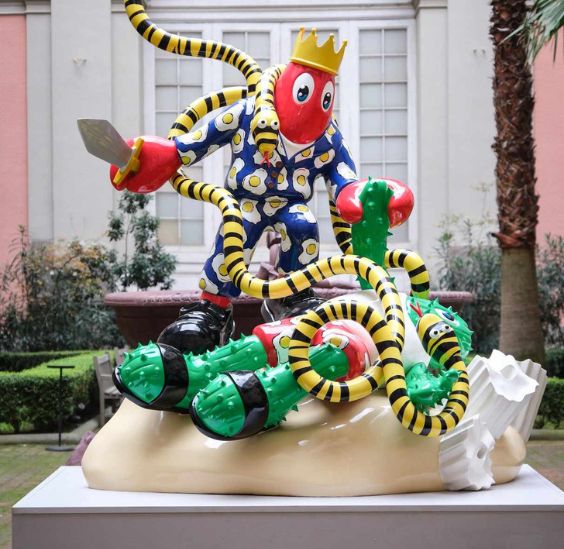
Impact and Significance in Naples
The “House of the Lobster” exhibition has made a significant impact on Naples’ cultural landscape. It has not only drawn attention to the National Archaeological Museum of Naples but also highlighted the city’s role as a hub for artistic innovation and dialogue. Colbert’s exhibition has become a beacon for cultural tourism, attracting art enthusiasts and curious visitors alike. This influx of visitors benefits the local economy and fosters a greater appreciation for both contemporary art and Naples’ rich heritage. The success of the exhibition also paves the way for future collaborations between contemporary artists and historical institutions in Naples. It sets a precedent for how modern art can engage with and reinterpret historical narratives, making them more accessible and relevant to today’s society.


